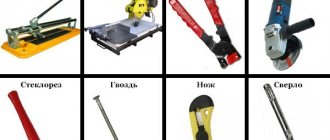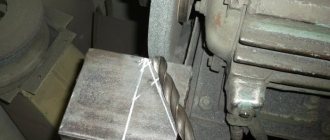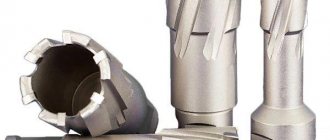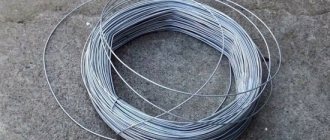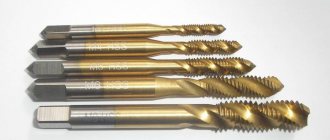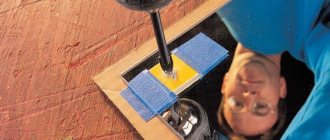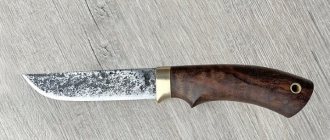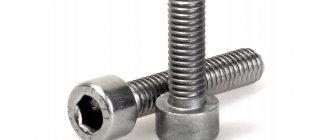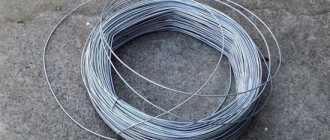Porcelain stoneware as a finishing material has gained great popularity over the past few years, which is largely due to its high strength and wear resistance. In order to process it effectively, it is necessary to use a special tool (for example, a drill for porcelain stoneware). The main difficulty in mechanical processing (including drilling) of porcelain stoneware products is that such a material, along with exceptional hardness, is also quite brittle.
For precise vertical drilling of porcelain tiles with a hand drill, you will need a diamond core bit with a centering drill, which can be supplied separately as an adapter
What is porcelain tile and why is it so difficult to process?
Manufacturers of artificial stones are constantly searching for the ideal material that would match the hardness of one, the beauty of another, and the wear resistance of a third. Perhaps they succeeded when porcelain stoneware was invented. This amazing stone is an alloy of quartz, kaolin clay, and feldspar. The result was a product that surpassed the properties of all three components. In this article, we are interested in its strength, because it is precisely this that prevents us from performing the usual actions characteristic of simple ceramics - drilling, cutting.
The Mohs scale places this stone on the same level as corundum, which is one higher than granite. The strength of porcelain stoneware is 7-8. Above it only diamond, sapphire, ruby. Based on this property, scratches, chips, and other mechanical damage are completely excluded.
The modulus of impact elasticity allows you to make floor coverings made of this material quite thin. For comparison, tiles 3 mm thick can withstand a weight of 200 kg.
The bending strength is 3 times higher than granite, which indicates the absence of fragility. The table shows the main physical and chemical characteristics of imported and domestic products that are useful for work. Comparing them with floor and wall ceramics speaks in favor of porcelain stoneware.
Characteristics of porcelain stoneware
Porcelain tile is an artificial material created from a mixture of granite chips and clay by pressing under high pressure and subsequent firing.
Due to its high density and strength, porcelain stoneware is used for flooring in industrial enterprises and public buildings. It is able to withstand increased loads without deformation.
Watch the video, types and types of porcelain tiles:
Porcelain tiles are also used for domestic purposes:
- Stair cladding;
- Pool linings;
- Fencing installations;
- Installation of facades;
- Installation of communications.
Despite its high strength ratings, this material can easily break under a directed impact. Therefore, it must be handled with care.
Features of working with porcelain stoneware
How to drill into porcelain stoneware material? The high density of porcelain stoneware is its advantage, however, working with this material requires highly durable tools. The tiles are cut, and drilled to lay the cord or install fasteners. For holes up to 12 mm in diameter, spear-shaped drills with a diamond tip are used, and for wider holes, diamond bits are used.
Watch the video, dry cutting using a grinder:
How to make a hole in a porcelain stoneware slab? To do this, use a cordless screwdriver, a two-speed drill without impact mode, a drill stand or a machine. Special diamond attachments are installed on the device:
- Crowns (ring drills);
- Diamond drills for vacuum sintered porcelain stoneware;
- Drills with sintered diamonds.
Crowns are rods with cups, the ends of which are coated with diamond crystals. The galvanic method of depositing crystals is characterized by a denser concentration of diamond segments compared to the vacuum method. The main advantage of galvanized diamond core bits for drilling porcelain stoneware slabs is their inexpensive price.
Drilling with diamond tubes:
A functional feature of crowns is the reduction of end pressure during the drilling process. The disadvantage is the small working resource. For example, such a crown will drill an eight-millimeter slab no more than four to five times. Crowns are used for drilling porcelain stoneware slabs for installation of electrical outlets or plumbing fixtures.
All crowns are different from each other:
- Wall thickness;
- Diameter;
- Length;
- Pitch of diamond segments;
- Number of cooling holes.
Vacuum sintered diamond drills for porcelain stoneware are the most durable tool. This drill owes its high wear resistance to the high concentration of diamond crystals firmly sealed into the metal. Diamond drills are characterized by high rotation speed and long working life: they can withstand 70 holes without a drilling machine and 120 - 150 holes using a machine. With the use of coolant, the wear resistance of a diamond drill for porcelain stoneware increases to 350 holes. The tool is developed on the basis of the latest technologies and enjoys exceptional confidence among craftsmen.
Expert advice on how to drill correctly:
Two-millimeter annular diamond drills are also used for drilling porcelain stoneware slabs. However, they create high end pressure, so they are mainly used for concrete slabs. The disadvantage is the low speed of the work process. However, the advantages include high strength: they can withstand up to hundreds of holes.
General information about porcelain tiles
Porcelain stoneware is a relative and direct successor of ordinary facing tiles. Interestingly, the world owes the appearance of this miracle of the construction industry to a banal violation of the technological process. The fact is that ordinary ceramic tiles are fired at a temperature of about 900°C. When the specified value is exceeded by several hundred degrees, the components of the mixture (quartz, kaolin, feldspar, etc.) begin to interact at the molecular level, which leads to their sintering into a monolithic mass.
Diagram for drilling tiles using masking tape.
This is a brief summary of the technology for manufacturing porcelain tiles. This process is quite similar to the processes occurring in the bowels of the Earth and leading to the formation of natural stone. Hence another well-founded name for porcelain stoneware – artificial stone.
Indeed, this unique material can not only compete with natural stone, but in some respects it is quite capable of surpassing it. Porcelain tiles have high strength and unsurpassed wear resistance. It is waterproof, resistant to temperature changes and aggressive chemical compounds.
We advise you to study - Rounded log - advantages and disadvantages of the material
One of the most important physical properties of porcelain stoneware is its exceptional hardness, which often exceeds that of natural granite! Different types can have a hardness of 6 to 8 on the Mohs scale (real granite has a hardness of no higher than 6).
With all this, porcelain stoneware is quite fragile, which, combined with high hardness, creates great difficulties in processing it. Making a hole in such material is much more difficult than drilling ceramics. To achieve the best result, it is necessary to use a special cutting tool for this purpose.
How to drill porcelain tiles at home
There is always a choice of drilling equipment, even in a home workshop. Anyone who likes to work with their own hands in a garage or in a box always has several options for tools:
- Manual carpentry drill;
- Drill with hand drive and collet chuck for drill;
- Electric drill with speed controller. If it is not possible to regulate the rotation speed of the chuck, then it is better to leave the electric drill alone;
- Screwdriver with speed controller and drill chuck.
You just need to decide what and how it will be more convenient to drill a hole in porcelain stoneware, taking into account all the circumstances and working conditions. To do this, you need at least a small but successful experience in working with ceramic tiles. The technique is the same, the technology is slightly different.
Hand tool
At first glance, a drill and a hand drill look archaic in an attempt to drill through porcelain tiles. Wrong opportunities. It is clear that it will not be possible to quickly drill porcelain tiles with a hand drill; no one sets such a task. With a hand tool you only need to make a point on the very hard, glass-like surface of the porcelain stoneware.
Without a centering point, the most expensive and powerful diamond bit will “walk” across the surface, scratching and leaving spirals.
For your information!
Sometimes it is easier to make the center with a core and one blow of a wooden hammer than to struggle with a drill. It all depends on the surface texture of the porcelain tiles.
Electric tool
Everything is simpler here. An electric drill or “shurik” must have a large torque, since you will have to drill at relatively low speeds. It is believed that it is best to drill porcelain tiles with a screwdriver; it produces a lower percentage of defects. But for drilling large diameters it is no longer suitable; at least an electric drill with a power of 1 kW or more is required.
Such devices, as a rule, provide a two-handed grip, which greatly simplifies the process, especially if you need to drill porcelain tiles for an outlet in the wall.
Work methodology
If you are drilling holes in porcelain stoneware, you should remember that diamond drills can become very hot during use.
In order to prevent the formation of microscopic cracks and destruction of the tiles, they must be cooled. The problem can be solved by applying water to the drill. To prevent heating, it is necessary to operate at medium speed. When porcelain stoneware is cut in an industrial environment, coolant is constantly supplied. At home, the drill can be cooled with water from a bottle. To do this, you need to make small holes in the lid through which water will flow to the drill. Some craftsmen do it even simpler: they cool the heated surface of the drill using a sponge moistened in advance.
Porcelain stoneware cutting technologies
When doing façade or interior work, it inevitably becomes necessary to cut the surface of the slab. This cannot be avoided, even recognizing that every good manufacturer has adapted elements for this or that case. You'll have to cut it. How and how to do this better, we will describe in more detail.
Dry cutting method with tile cutter
Everyone has heard about tile cutters, but many read on forums that it is impossible to halve a capricious stone with this tool. This is not entirely true. Mechanical or manual tile cutters are also different. With the right skill, everything will work out great. We are interested in a tool with a diamond roller.
The work stages will be as follows:
- We inspect the device for suitability for work. We are interested in the diamond roller, which can fail, in other words, wear out. The fastening system may become loose. If there are chips on the edge, the part must be replaced. When you turn it on and try to use it, the roller should not move. Then it is tightened or the entire fixation system is changed. Ignore it, and cutting the tiles will be impossible.
- If your tile cutter is based on bearings, then lubrication will not interfere with them, since even a slight “looseness” will lead to chips.
- Now draw a cutting line with a marker and place the roller at the beginning of the line. When inserting the tile into the device, try not to follow the line with the cutting element.
- Now you need to fix the plate with your hand, lift the handle, lower it until the roller touches the surface, but the paws remain in the air.
- Now comes the most important part. Using gentle pressure, guide the handle to the end of the tile along the marked line. It is important not to press too hard so that the surface remains without chips. It will be superfluous to pass the cutting element ten times. This way you will only achieve an unsightly cut. Once is enough.
- Now raise the foot again and lower it again, but now so that the feet touch the surface on both sides of the cut. Press down and break the material.
If the cut is rough, you can use a grinder.
Cutting with a grinder
The following method has gained the greatest popularity among the people. Buying a tile cutter for a dozen tiles is not profitable. But almost every zealous owner has a grinder. We will need a dry cutter or a special diamond disc for porcelain tiles.
The whole job consists of placing the disc in the grinder and cutting off a part from the tile. It would seem that’s it, but there are some nuances:
- Remember that you need to cut in the direction of rotation of the disk, and not vice versa. This will protect you from fragments that fly in the opposite direction from rotation. And there will be fewer chips.
- The disadvantage of this process is the mandatory formation of chips on the front side. Only skill will help minimize this. Make only one cut. Any subsequent ones will leave unsightly edges.
- Another feature of working with an angle grinder is that you need to cut not along the line itself, but 2 mm from its edge. This will leave you room to sand down the chips.
- A huge advantage of using an angle grinder is the ability to make curly lines, although it is better to practice first.
Wet cutter for tiles
What to do if you have to cut a lot and efficiently? Then an electric tile cutter will help. It is also called a wet cutter due to the peculiarities of the process, but in order.
You need to figure out what kind of wet cutter you got. They differ in the way the work is performed. One is designed so that the disk moves, the table remains stationary. On another tile cutter, the substrate moves, but the cutting element remains motionless. They may differ in the method of cooling and wetting. In one device, a container of water is installed directly under the disk. It must be said right away that the water must be changed frequently, otherwise dirt with large particles will worsen the cutting quality and shorten the service life of the disc. In another instrument, water is supplied from above.
Working with an electrical device is easier than with a mechanical one. Lay the tiles on the table, fix them on both sides with your hands. Press firmly enough to eliminate vibration, which can cause chipping. Now make the cut from start to finish without much effort.
Important! Try to avoid vibration, as the disc may jam in the material, which will lead to unpredictable consequences.
Be sure to clean the disc, because it will probably become clogged with crumbs. To do this, run it along a sand block or brick.
Each of these methods involves developing skill, up to cutting curly lines, but this is difficult to do. It is almost impossible to cut out figures, ornaments and other beautiful decorative elements at home. For this purpose, there are special machines that operate on the basis of waterjet. In production there are special high-precision milling cutters that cut porcelain stoneware surfaces like butter.
Drilling methods
There are 2 options for drilling porcelain stoneware:
- Diamond-coated crowns;
- Tubular diamond drills.
In essence, these are the same thing, but it is generally accepted that crowns are for large diameters. There are also differences in drilling methods: wet or dry.
A carbide-tipped drill or ballerina drill quickly becomes dull and is not suitable for this. If you need to drill through natural granite, you can do it in another way - with a hammer drill in the impact mode using a concrete drill. Its tip should be sharply sharpened in the shape of a chisel.
Diamond crowns
Diamond crown
- A porcelain tile cutter requires water to be supplied to the work area for cooling. This can be done by gradually adding water from a rubber bulb or a regular glass.
- It is advisable to start drilling with the jig at a right angle.
- The drill should be in drilling mode without impact, at low speeds. With a diameter of up to 30 mm, the maximum drill should operate at 600-800 rpm, if the diameter is larger - a maximum of 300-400.
Drilling a hole for the toilet with a 6 mm crown through a homemade jig
On sale you can find crowns with a diameter of 5 mm, they cost from 300 rubles and more.
Diamond drills
If diamond core bits are used for wet cutting, then Bosch diamond-coated drill bits must be used dry. Associated with this are some features of their use, the implementation of which will extend their service life.
Inside the drill there is a coolant - olive oil. Other manufacturers do not have it, and you need to use them like regular crowns “on a wet basis.”
- Initially, hold the drill at an angle of approximately 45 degrees. In this case, you need to bring an already working drill to the surface, otherwise, when turned on, the drill on the porcelain stoneware will move away and damage the glaze.
- When you warm up the drill, you need to place the drill perpendicular to the porcelain stoneware and continue drilling with slight circular rocking. There is no need to press hard. The optimal drilling speed is 1500 rpm, without impact. This is done so that part of the diamond coating has time to cool. When the oil inside heats up, it will begin to come out and pick up sludge (dust), helping with cooling.
- After drilling, be careful not to point the tip of the drill at your face - hot oil expands and can shoot.
Start drilling at an angle so that the oil inside warms up and comes out
An important point: once you start drilling porcelain tiles, you cannot stop. The oil and spray will cool down, and you will need to warm it up again, and this reduces the service life. This rule does not apply to ordinary tiles.
The Easy Dry diamond drill bit for porcelain tiles from Bosch can be found for hole diameters from 6 to 14 mm. It is suitable for drills and screwdrivers with a drill shank with a diameter of 13 mm. Cost - from 1100 to 1800 rubles. There are similar models of grinder drills with a diameter from 14 to 70 mm, called Easy Dry Speed.
In practice, it was enough to drill 5 holes in regular tiles, 4 in medium-density porcelain tiles and 1.5 in class 4 hard porcelain tiles from Kerama Marazzi.
There are also cheaper analogues, for example, diamond drills from Hawera can be found for a diameter of 5-14 mm, they cost about 800 rubles apiece.
Straight cut
The need to cut the cladding usually arises in areas adjacent to adjacent walls and communications. Before drilling porcelain tiles, it is necessary to cut them to size, since once a hole appears in it, the strength decreases sharply. This is especially true for products with a superheated middle reinforcing layer. You can make a straight cut using several methods, listed below in order of increasing complexity:
- manual glass cutter - due to the significant thickness of the tiles compared to glass, you should hold the tool and press it to the surface with both hands, so the line is drawn in advance; it is not recommended to cut porcelain tiles using a ruler;
- tile cutter - a budget option - the cut is made once with one touch, so there is no need to rush, you should ensure uniform pressure throughout;
- Angle grinder - it is better to use a diamond wheel, since the equipment for stone or concrete is thicker and less reliable; first, the tile is cut along the entire length by a third, then the inner layer is cut.
Unlike a tile cutter, a glass cutter is not equipped with a device for splitting tiles at the cutting site. Therefore, several options are used:
- the partner presses the tile, previously aligned with the cutting line along the edge of the tabletop, with his own weight to the table, the master breaks off a piece with a sharp downward movement of both hands;
- A steel bar or wooden bead of the smallest possible cross-section is placed under the cutting line, the tiler jumps 10–15 cm, and lands with both feet on opposite sides of the tile.
The last method is suitable when working alone; shoes should have soft soles, and foam material or cardboard should be placed under the edges of the tiles. The first and last options do not provide a perfectly straight cut line. However, in the case of an angle grinder (“grinder”), this defect can be corrected by using a special device for the tool. This is a platform with a slot for a disk, similar to the platform of a hand-held circular saw (“circular saw”), rigidly fixed with a screw or bolt into the threaded hole for the angle grinder handle. Before starting work, the cutting depth is set - in this case, about 2mm. After passing the diamond disc along the entire length, the adjustment changes to the entire thickness of the porcelain stoneware in order to cut through the material. In this case, a side stop is used, fixed to the platform, the cut is smooth, almost like a tile cutter. In any of these options, the curvilinearity of the cut line can be eliminated by grinding on an abrasive wheel. The chamfer on the front surface is made only by hand using a block or round stone.
Attention:
The equipment of a manual glass cutter or tile cutter (roller, diamond) must be sharpened. It is not allowed to repeat the tool along the same line. Such tiles will not crack evenly, and the decorative layer will be damaged in areas adjacent to the cutting line.
How to drill without cracking the material?
You can avoid breaks and cracking of tiles by following several recommendations:
- Do not use an electric drill at speeds above 1000 rpm.
- If you need to drill into ceramics that have not yet been laid on the wall, soak them in a container of water for 60 minutes.
- Before you start drilling, make sure that the hammer function is turned off on the device.
- Practice on an unnecessary piece of tile to choose the optimal operating mode for the screwdriver and the pressure force.
- Do not put the unit in reverse mode.
- When drilling close to the edge, it is better to move the drill bit into the joint, otherwise it will slide off the edge of the tile.
- Start drilling at low speeds and gradually increase speed.
And finally, it is worth mentioning personal protection measures - eye and respiratory safety. During drilling, pieces of glaze and dust fly off the tiles, so do not neglect such basic means as glasses, gloves and a mask.
Drills for porcelain stoneware: features and varieties
Kinds
Processing porcelain stoneware is a complex process that cannot always be accomplished with a conventional drill for concrete. This is due to the monolithic structure of the material, which is not destroyed by such exposure.
Today, several types of drills can be used to work with porcelain stoneware:
- Feathers. Only tools that are equipped with a pobedite or diamond tip are suitable. However, they are not designed to work with such materials, so after creating a few holes, you will simply throw the product away.
- Annular drills. Outwardly, they resemble small cylinders with diamond chips. With these tools you can make many holes (more than 100-150 pieces).
The working surface of a tubular drill has no slots and is a solid circle. This does not allow for efficient removal of dust that is formed during drilling. This also creates strong pressure on the surface of the tile, which can lead to cracking. For this reason, you should work with tubular drills at low speeds, periodically removing the tool to remove dust.
- Diamond crowns. This is a universal tool that is most often used for working with concrete. It can also process porcelain tiles.
The disadvantage of products with galvanic coating is the minimum service life. The structures fail after 5-6 holes. This disadvantage is compensated by the low cost, which allows you to stock up on products in the required quantities. When working with diamond bits, you should not worry too much about excess pressure, since it is reduced due to special slots at the ends of the tool.
Processing of porcelain tiles is also possible using conventional drills that are tipped with porcelain. However, it should be understood that they are not designed for such materials, so their service life will also be limited to a few drills.
After this, the tool will no longer be able to be used for its intended purpose.
Dimensions
One of the criteria when choosing a drill for porcelain stoneware is the diameter of its cutting area.
Today there are many sizes of such tools on the market, among which there are several popular options:
- 6 mm;
- 8 mm;
- 10 mm;
- 12 mm.
These types are the most popular. If we analyze diamond bits, the diameter of the drill varies from 8 to 150 mm (depending on the manufacturer). The most popular are 20-100 mm cylinders, which are intended for forming holes for water pipes in apartments or private houses.
Please note that the pitch of each drill is standard in most cases. However, there are models in which the diameter is measured not in millimeters, but in inches. This fact is important to consider if the hole dimensions must be accurate.
Review of popular products
The technical characteristics of drills for porcelain tiles and crowns depend on the method of manufacturing and fastening diamond crystals.
There are:
- Powder metallurgy method
- Galvanic method
- Diffusion-vacuum method.
The advantages of powder metallurgy include the durability of the drill and a high working life. The advantages of galvanic products are low cost. But the most durable and effective drill for porcelain tiles is a vacuum drill.
Product overview:MonAliT (Russia)
MonAliT diamond drills for porcelain stoneware slabs of diffusion welding operate with water cooling. The production life of drills using diffuse-vacuum welding, in contrast to galvanic spraying, increases by 50 times.
MonAliT models have a diameter from three to seventy millimeters. The price of products increases in proportion to the diameter and ranges from 520 to 6,980 rubles (for 700 mm).
Product overview:Hawera (Germany)
Hawera diamond drill bits for vacuum soldered porcelain tiles are sold in a set of three pieces. The products are highly durable. Thanks to the self-cooling function, the drills operate without being wetted by water.
Watch a video about this product:
Another feature of Hawera diamond drills for porcelain stoneware is the ability to work without centering devices (holders and machines). Set contents: drills with a diameter of 6, 8 and 10 mm. The price of the set is 5,600 rubles.
Product review:Bosch Easy Dry Best (Germany)
A special feature of the Bosch Easy Dry Best diamond drill is dry drilling. You do not need to constantly cool the drill, as the design provides cooling of the crystalline segments using automatic fluid supply to the tip. The coolant flows through the tip of the drill along the porcelain stoneware when the operating mode is turned on. The price of the product is 1120 rubles.
There is coolant inside the drill. Other manufacturers do not have it, and you need to use them like regular crowns “on a wet basis.”
Adviсe
When working with the tool, it is worth considering some useful recommendations. In this case, you can achieve wonderful results.
For toilet mount
To make a hole for a toilet mount in existing porcelain tiles on the floor, you need to use a diamond core bit. Typically this is a 10 mm diameter crown, which must be used with water.
With such a crown it is necessary to work with a special additional tool - a jig. If there is no conductor, then you can make it yourself by drilling a corresponding hole in the board.
Then you need to make a mark on the porcelain stoneware. Align this mark with the hole in the jig and begin drilling. After some time, it will be possible to remove the conductor and continue working without it. Having drilled through the porcelain slab to the end, the diamond bit can be replaced with an ordinary drill and used to drill a hole for attaching the toilet.
Under the socket
It is recommended to make a hole for the socket box before laying the tiles. Markings are drawn on the front side of the ceramic tile, and a mark is made in the center of the intended hole with a small diameter drill. Then a large diameter diamond bit is taken, which is necessary to install the socket. Then the porcelain stoneware is drilled through.
To prevent the instrument from overheating, you must use water.
Auxiliary Tools
If you constantly drill porcelain stoneware, you can purchase centering templates for convenience. There are attachments for diamond bits and separately for drills.
Centering device (template) and drill cooling cylinder
For one-time work, you can quickly build a jig from a piece of board or plywood by drilling a hole of the appropriate diameter in it. This template will prevent the drill from moving to the side in the first seconds. Additionally, you can apply masking tape to the surface.
